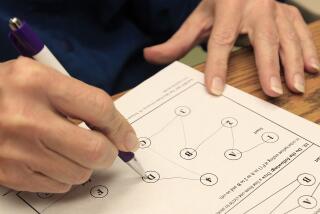Computer Skill Test Helps Detect Drug Use : Employees’ union, others say on-the-spot performance drill is more effective, less intrusive than urinalysis.
- Share via
WASHINGTON — Civil libertarians and a major government employees’ union are pushing for a new kind of test to replace urinalysis in detecting drug use among employees whose impairment could jeopardize public safety.
Advocates of the new method--called performance testing or impairment testing--contend it is cheaper, more effective and, above all, much less intrusive than urine testing.
A leading form of performance testing is a computer game-like device that tests a worker’s judgment and response time through a person’s ability to manipulate a cursor on a computer screen. Each exam is measured against the employee’s personal base line score that is established in an earlier test.
In one version, the employee moves a control knob, trying to keep the cursor centered on the screen while the computer moves it away from the center at an increasingly rapid rate.
Aside from being less intrusive, the tests can be administered quickly. In one system, developed by Performance Factors Inc. of Alameda, Calif., the test is over in less than 30 seconds--the point at which the average user reaches peak ability to control the cursor.
For older workers who object to playing computer games at which their children often best them, proponents point out that they are playing against their own records--and not the machine or other competitors.
BACKGROUND: In the wake of railroad, airline, subway and bus accidents in which drugs and alcohol were found to have played a role, federal regulatory agencies--upheld by the Supreme Court--are requiring random drug testing for safety-sensitive positions, such as railroad and subway operators.
Opponents of such testing, led by the American Civil Liberties Union, say urinalysis does a poor job of detecting drug impairment. Also, samples must be sent to a laboratory for analysis.
“The quick fix of drug testing does absolutely nothing to prevent on-the-job impairment,” said one official of the American Federation of State, County and Municipal Employees.
But even instantaneous results would not send conclusive warning signals, they contend. Between the time someone smokes marijuana or snorts cocaine, at least several hours must pass before the incriminating metabolites appear in the urine. Thus, an airline pilot who ingests cocaine on the way to the airport and then takes a urine test would pass, according to the ACLU.
A direct test of psycho-motor impairment by a performance-testing device, however, would show that the airline pilot or subway operator or other subject was not up to his usual performance, advocates contend.
ISSUES: Both proponents and detractors of impairment testing note that it does not reveal the causes of impairment. These could range from drugs and alcohol to sickness, fatigue or being distraught over a death in the family or divorce.
Proponents contend that impairment testing avoids rummaging around in Americans’ private lives, searching their bodies and analyzing their body fluids without any indication that they have done anything wrong.
“No one has to drop their pants to take an impairment test,” Lewis L. Maltby, director of the ACLU’s task force on civil liberties in the workplace, told a House subcommittee recently.
The system has some obvious drawbacks. It is not useful for pre-employment testing because of the need to establish a personal base line, which takes about 20 days, according to Joseph Kupfer, president of Council 18 of the American Federation of State, County and Municipal Employees in Albuquerque, N.M.
What’s more, there is no data on how the test would work if an alcoholic or chronic drug abuser established a base line while under the influence.
Another drawback is that the system requires up to daily access to an appropriately programmed computer for a few minutes, a requirement that could make it impractical for employees in remote locations without such devices.
Despite its advantages, it may be some time before performance testing replaces current forms of testing.
Hearings have been held in the House, but a source said changes in testing law are not likely in an election year.
Screening Out Troubled Workers
Companies use the Factor 1000 computer to test workers’ reflexes before they begin work. It can alert companies about employees who are unable to perform critical tasks due to such problems as substance abuse or illness. Here is how it works:
1. Employee enters identification number onto pad to the far left of control panel.
2. Test screen comes up.
3. Employee presses red button to begin test.
4. The objective: to keep the diamond centered as it tries to move to each side of the screen. Employee turns the silver knob left or right to correct the diamond’s erratic movement.
5. Diamond becomes more and more unsteady, moving randomly left to right. The system’s developer compares it to trying to balance a broomstick in the palm of your hand. As the swaying becomes more extreme, the corrections become trickier.
6. Test ends when diamond hits into either the left or right boundary, usually 30 to 60 seconds into test.
7. Computer compares the employee’s performance to past performances and gives either a passing or failing mark on the test.
8. It is up to each company to establish policies regarding a failing grade. Some let the employee take the test again; others may require a conference with a supervisor.
Source: Performance Factors
More to Read
Sign up for Essential California
The most important California stories and recommendations in your inbox every morning.
You may occasionally receive promotional content from the Los Angeles Times.













